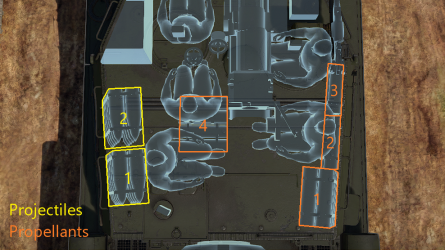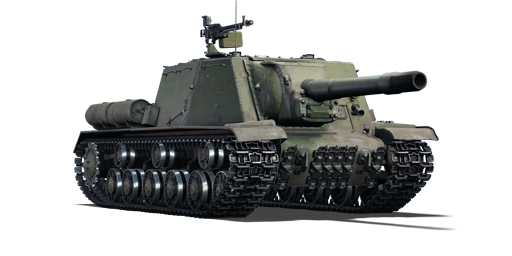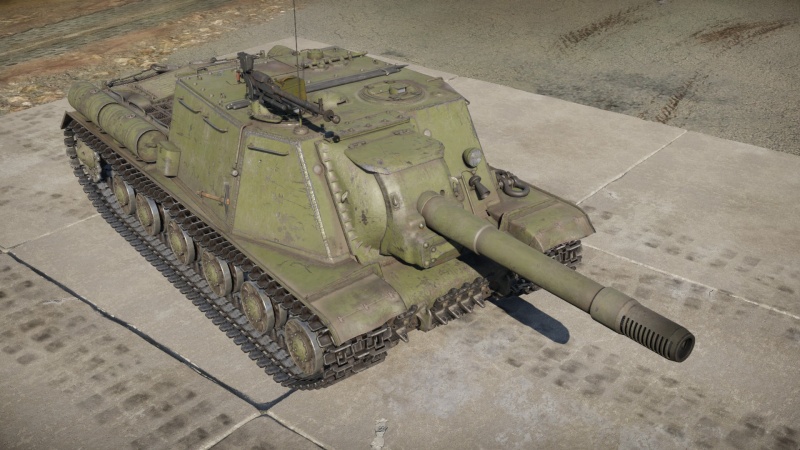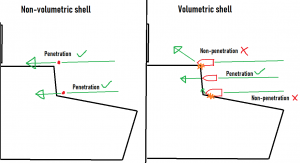ISU-152 (China)
Contents
Description
The ␗ISU-152 is a rank Chinese tank destroyer with a battle rating of (AB), (RB), and (SB). It was introduced in Update 1.91 "Night Vision".
General info
Survivability and armour
The ISU-152 is inadequately protected against most enemy tanks. The vehicle is armoured mainly with 90 mm of rolled homogenous armour (RHA), covering the sides, back and front glacis. The only thicker armour section (100 mm) covers the curved gun mantlet. Against tank guns, this level of protection is inadequate as the ISU-152's armour plates are all poorly angled and not thick enough. The gun mantlet might bounce some shells sometimes, but never count on that. However against SPAA the ISU has very good armour, as most SPAAs' penetration are lower than 60 mm. The top of the vehicle is armoured with 30 mm of RHA, meaning that most cannon-calibre aircraft projectiles will not penetrate it with ease.
In terms of survivability, the ISU-152's five crew members are somewhat spread out, meaning that with a frontal penetration by an explosive-filled shell, the chances of an instant crew-knock are smaller. The large gun breech can also block some shrapnel for the crew on one side. But with a side shot through the superstructure, or if a large-calibre shell pentrates, the crew are very likely to get knocked out instantly. The main weakness in the ISU-152's protection are it's ammo racks. The vehicle has two large ammo racks (shells on the left side, charges on the right side) that sit directly underneath the side 90 mm RHA belts. This means that any shot that penetrates the side of the hull will likely cause an ammo rack detonation. The engine is located at the very rear of the vehicle, covered by fuel tanks.
Armour type:
- Rolled homogeneous armour
- Cast homogeneous armour (Gun mantlet)
| Armour | Front | Sides | Rear | Roof |
|---|---|---|---|---|
| Hull | 60 mm (75°) Front glacis 90 mm (31°) Lower glacis |
90 mm | 60 mm (50°) Top 60 mm (39°) Bottom |
30 mm |
| Superstructure | 90 mm (29°) Front glacis 65 mm (7-69°) Gun mantlet case 100 mm Gun mantlet (0-45°) |
75 mm (14-15°) | 60 mm (1°) | 30 mm |
Notes:
- Suspension wheels are 20 mm thick while tracks are 30 mm thick.
Mobility
| Game Mode | Max Speed (km/h) | Weight (tons) | Engine power (horsepower) | Power-to-weight ratio (hp/ton) | |||
|---|---|---|---|---|---|---|---|
| Forward | Reverse | Stock | Upgraded | Stock | Upgraded | ||
| Arcade | Expression error: Unexpected * operator. | 739 | Expression error: Unexpected round operator. | __.__ | |||
| Realistic | 460 | Expression error: Unexpected round operator. | __.__ | ||||
Modifications and economy
Armaments
Main armament
The ISU-152 carries, as the vehicle name suggests, a massive 152 mm gun. The gun has a massive 20+ second reload time, and packs a similarly-massive punch. The ML-20S is a Soviet WWII-era howitzer, developed from a WWI-era howitzer. The weapon can fire an extremely powerful APHE shell with 170 mm of penetration, while still packing 740 grams of TNT filler. The tank can also fire HE shells with 5.9 kilograms of explosive, as well as an APHEBC shell with more TNT filler. In addition, a HEAT shell is available to deal with any heavily-armoured tank in an uptier, thanks to the amazing 250 mm penetration. Thus, the shells can easily penetrate the frontal armour of almost all tanks at the ISU-152's BR. In particular, the APHE/APHEBC shells can come as a nasty surprise, as they pack an impressive punch combined with strong penetration ability.Recommended ammunition to bring is a combination of APHEBC and HEAT rounds. The APHEBC is great at vaporising average targets at the ISU-152's BR (eg. Pz.IV.H, Chi-Ri, M4A3, etc). The HEAT, on the other hand, is for heavy tanks when you are in a full uptier. For example, the frontal armour of M4A3E2, Panther A/D, and Churchill VII can all be easily penetrated with the shaped charge. HE shells are not very useful, as they cannot penetrate tanks, and HEAT can do a similar job at hull-breaking light vehicles.
Many players find the long reload of Soviet large-calibre guns very harsh. If one misses or fails to one-shot the target, they must wait for another half a minute reloading. However if one masters the trajectory and velocity of such guns, it can become very effective at one-shotting enemies. In most cases, after destroying a target there would be quite some time before the next target shows up, eliminating the disadvantaged reload time. Nevertheless, vehicles with this reload speed like the ISU-152 is definitely not suitable to hold down a line where multiple enemies are charging simultaneously.
The last aspect to overcome is the extremely poor gun depression of only -3 degrees. This requires the player to only fight on flat ground, preferably in an urban environment, to avoid having to hull down. In a hilly map (eg. Karelia) find spots where there is absolutely no slopes.
| 152 mm ML-20S | Turret rotation speed (°/s) | Reloading rate (seconds) | |||||||||||
|---|---|---|---|---|---|---|---|---|---|---|---|---|---|
| Mode | Capacity | Vertical | Horizontal | Stabilizer | Stock | Upgraded | Full | Expert | Aced | Stock | Full | Expert | Aced |
| Arcade | 20 | -3°/+20° | -3°/+7° | N/A | 7.0 | 9.8 | 11.8 | 13.1 | 13.9 | 27.69 | 24.50 | 22.58 | 21.30 |
| Realistic | 4.8 | 5.6 | 6.8 | 7.5 | 8.0 | ||||||||
Ammunition
| Penetration statistics | |||||||
|---|---|---|---|---|---|---|---|
| Ammunition | Type of warhead |
Penetration @ 0° Angle of Attack (mm) | |||||
| 10 m | 100 m | 500 m | 1,000 m | 1,500 m | 2,000 m | ||
| BR-540 | APHE | 170 | 169 | 161 | 152 | 144 | 136 |
| OF-540 | HE | 49 | 49 | 49 | 49 | 49 | 49 |
| BR-540B | APHEBC | 166 | 164 | 157 | 148 | 140 | 133 |
| BP-540 | HEAT | 250 | 250 | 250 | 250 | 250 | 250 |
| Shell details | |||||||||
|---|---|---|---|---|---|---|---|---|---|
| Ammunition | Type of warhead |
Velocity (m/s) |
Projectile Mass (kg) |
Fuse delay (m) |
Fuse sensitivity (mm) |
Explosive Mass (TNT equivalent) (g) |
Ricochet | ||
| 0% | 50% | 100% | |||||||
| BR-540 | APHE | 600 | 48.8 | 1.2 | 19 | 739.2 | 47° | 60° | 65° |
| OF-540 | HE | 655 | 43.56 | 0 | 0.1 | 5,900 | 79° | 80° | 81° |
| BR-540B | APHEBC | 600 | 48.96 | 1.2 | 19 | 1,020 | 48° | 63° | 71° |
| BP-540 | HEAT | 680 | 27.67 | 0.05 | 0.1 | 5,910 | 62° | 69° | 73° |
Ammo racks

| Full ammo |
Ammo type |
1st rack empty |
2nd rack empty |
3rd rack empty |
4th rack empty |
Visual discrepancy |
|---|---|---|---|---|---|---|
| 20 | Projectiles Propellants |
11 (+9) 11 (+9) |
1 (+19) 9 (+11) |
N/A 7 (+13) |
N/A 1 (+19) |
No |
Notes:
- The ISU-152 (China) uses two-piece ammunition, composed of projectiles (yellow) and propellant bags (orange). Both have separate racks.
Machine guns
| 12.7 mm DShK | ||||
|---|---|---|---|---|
| Mount | Capacity (Belt) | Fire rate | Vertical | Horizontal |
| Pintle | 250 (50) | 600 | -5°/+85° | ±180° |
Usage in battles
The ISU-152 is a tank destroyer with a huge 152 mm cannon which can one-shot any target that it penetrates. In an uptier, the gun is equipped with a HEAT shell that has enough penetration to destroy even the most armoured heavy tanks. However, the gun comes with its drawbacks. Its reload time is long, shell velocity is low, and on top of that, shell drop must be accounted for when aiming. This makes aiming and leading at long ranges difficult--indeed, the ISU-152 is best at close and medium ranges.
The gun has a very small gun depression, which means that the ISU-152 is unsuited for hilly maps and for firing from behind ridgelines. Flat, urban terrain lets this vehicle use its gun to the greatest potential.
Of course, the ISU-152 is not a turreted vehicle, and this means that flankers such as the M18 Hellcat are extremely dangerous. Worse, the ISU-152 is quite sluggish in the mobility department. Repositioning in order to face an enemy takes a considerable amount of time, which means that it's necessary to keep a careful eye out for flankers, and to plan escape routes in dangerous situations.
As for armour, the ISU-152's protection is average. Its roof armour can protect against aircraft machine guns and some 20 mm cannons, and its side armour protects well against SPAA guns. However, the frontal armour is easily penetrated by many of the guns at this tier. And, the tightly-packed arrangement of the crew inside the vehicle means that being one-shot is not a rare occurrence in this vehicle.
Provided you have the HEAT shell unlocked, the ISU-152 is a exceptional machine to use in a full uptier and even beyond, with up to 250 mm of armour penetration. The HEAT shell on the ISU-152 is identical to the one on the Object 268, a BR 7.3 tank destroyer, with the same armour penetration stats to boot. With the extra silver lions obtainable from the "Rank does not matter" achievement, the ISU-152 may actually be more effective in a uptier then at the same tier.
With the introduction of volumetric shells, vehicles with large-calibre cannons are negatively affected, and that of course includes the ISU-152. The large calibre shells now will catch any obstacle in their flight path, and either ricochet away or keep flying after losing a significant amount of penetration, which is different from before where shells are just a pixel that can go through small gaps. This is especially obvious when shooting vehicles like the Tiger I, they have many edges and small slopes that will cause your 152 mm shells to bounce. Therefore you must ensure that your shell will land at an area without any obstruction (eg. shoot at the dead centre of a Tiger I's frontal hull where the armour is clear, instead of shooting right next to the MG port where the spherical port might bounce off the shell)
Pros and cons
Pros:
- Deadly cannon provides superior one-shot capacity with any target upon penetration
- Powerful HEAT penetrates up to 250 mm which is very effective in a full uptier. For example the early Centurions, Ferdinand, Tiger II H can all get penetrated with ease.
- Destructive anti-personnel effect of HE can knock out crew of almost all target
- Fast reverse of ~-15 km/h allows flexible tactics and retreats
- The huge gun mantlet and its complex armour layout is capable of deflecting quite some shells sometimes.
- 30 mm roof armour resists popular aircraft weapons well, like the 12.7 mm M2 with ground target belt and the MG 151.
- All-round protection provides good resistance against flanking SPAAs. The M19 / M42 are very common flankers.
- Roof-mounted 12.7mm heavy MG rotates 360° around, allowing the ISU to fight back at a lightly armoured flanker even when immobilised
Cons:
- Long reload of more than 20 seconds and the rather curved trajectory demands very precise aiming, which isn't beginner friendly.
- Front armour is only 75 mm and is not well angled. Gets penetrated easily by common guns at the BR, like the 76 mm M1, 17 pdr, 75 mm and 88 mm.
- Closely packed crew all easily get killed when an explosive shell penetrates.
- Very inadequate gun depression of -3° combined with the sluggish mobility makes it only capable of fighting in urban (flat) areas, but never the hills.
- Turretless layout and the sluggish mobility makes it very vulnerable to surprise flankers, for example the infamous M18, T20, T25 and Puma.
- Gun breech often gets damaged while under enemy fire.
- 12.7mm heavy MG has a very small magazine size (50 rounds). Reloads are constant
History
Development
Development of the ISU-152 already started alongside the SU-152, its predecessor. The SU-152 was based off the KV-1S tank, which itself is a lighter version of the KV-1 heavy tank. The vehicle, while highly praised in its performance, saw a need for modernization with the KV-1's phasing out of the Soviet's inventory and being replaced with the new IS heavy tanks. The modernization process began on May 25, 1943, with the goal of using the IS tank as the basis of the vehicle and also increasing armour protection alongside other improvements. Development began in July under Joseph Yakovlevich Kotin, a chief designer of Soviet heavy tanks, who worked alongside G. N. Moskvin as the main designer. The designing of the improved vehicle went on for a month before the first variant was ready, designated the IS-152. This was tested in September 1943, which revealed defects and deficiencies with the design, so it was redone into a second variant called Object 241 in October 1943. Trials began on Object 241, which was successful through the factory and state trials and adopted on November 6, 1943, as the ISU-152. Production began in December at the Chelyabinsk Kirovsk Plant, producing 3,242 units from then all the way until 1947, with 1,885 units made by the end of World War II.
Design
The ISU-152 was the successor to the SU-152, retaining the same 152 mm ML-20S howitzer needed to destroy enemy fortifications in offensive operations. The vehicle was run on a torsion-bar suspension system from the IS tank chassis. The crew consists of four or five men in the vehicle, the optional crew member being a loader. The crew had external views through periscopes and two gun sights, a panoramic and a telescopic one. Crew communication was possible with an intercom system and a 10R or 10RK radio was available to communicate between vehicles. The crew had access to two PPSh submachine guns and grenades in the tank to defend themselves against infantry.
A drawback to the vehicle's design was the gun ammunition and internal storage. The large ammunition pieces were limited to about 20 rounds in the vehicle, and each round was extremely heavy and large that reloading the tank can take up to 40 minutes and lots of strength. Rate of fire was also reduced by the ammunition's heavyweight.
Media
Excellent additions to the article would be video guides, screenshots from the game, and photos.
See also
Links to the articles on the War Thunder Wiki that you think will be useful for the reader, for example:
- reference to the series of the vehicles;
- links to approximate analogues of other nations and research trees.
External links
Paste links to sources and external resources, such as:
- topic on the official game forum;
- encyclopedia page on the tank;
- other literature.
| China tank destroyers | |
|---|---|
| PLA | |
| Gun vehicles | PLZ83 · PLZ83-130 · PLZ05 · PTZ89 |
| Missile vehicles | AFT09 |
| ROC | |
| Missile vehicles | CM25 |
| USA | |
| Gun vehicles | ␗M8 HMC · LVT(A)(4) (ZiS-2) · ␗M10 GMC · ␗M36 GMC |
| Missile vehicles | ␗M113A1 (TOW) |
| USSR | |
| Gun vehicles | ␗SU-76M · ␗ISU-152 · ␗ISU-122 · ␗SU-100 |






